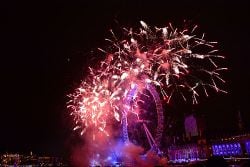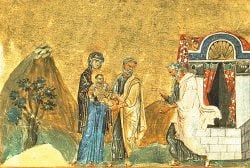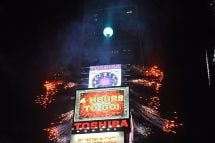New Year's Day, also simply called New Year or New Year's, is observed on January 1, the first day of the year on the modern Gregorian calendar as well as the Julian calendar. It is also celebrated in other cultures, such as the Chinese New Year which occurs based on the Chinese calendar.
Celebrations often include large displays of fireworks at midnight, welcoming in the New Year. In contemporary times these are broadcast around the world as the New Year begins in each time zone. Many traditions involve spending time with friends and family, enjoying sports and other entertainment.
The New Year is an opportunity for people to reflect on the good and bad in the year that is ending, and to resolve to do better in the coming year. Many customs involve bringing prosperity and good fortune to others, such as "first-footing" and the eating of "good-luck" foods.

History
Mesopotamia (modern-day Iraq) instituted the concept of celebrating the New Year in 2000 B.C.E. This celebration took place around the time of the vernal equinox, in mid-March.[1]
The early Roman calendar, consisting of ten months, designated March 1 as the first day of the year.[2] Then, in pre-Christian Rome under the Julian calendar, the day was dedicated to Janus, god of gateways and beginnings, for whom January is also named.
The January Kalends (Latin: kalendae, the first day of every month) came to be celebrated as the New Year after it became the day for the inaugurating new consuls. Romans had long dated their years by these consulships, rather than sequentially. In 153 B.C.E. they aligned this dating with the calendar year by making the kalends of January the first day of the new year. Still, private and religious celebrations at the March new year continued for some time.[3]
As a date in the Gregorian calendar of Christendom, New Year's Day liturgically marked the Feast of the Naming and Circumcision of Jesus, which is still observed as such in the Anglican Church and Lutheran Church.[4] Once it became the new year, however, it became a time for family gatherings and celebrations.
At various times and in various places throughout medieval Christian Europe, the new year was celebrated on December 25 in honor of the birth of Jesus; March 1 in the old Roman style; March 25 in honor of Lady Day and the Feast of the Annunciation; and on the movable feast of Easter. These days were also astronomically and astrologically significant since, at the time of the Julian reform, March 25 had been understood as the spring equinox and December 25 as the winter solstice. The winter solstice had long been a time of festivity in every traditional culture, and Christmas with its gift-giving blended into this mythical context.[5]
Among the seventh-century pagans of Flanders and the Netherlands, it was the custom to exchange gifts on the first day of the new year. On the date that European Christians celebrated the New Year, they exchanged Christmas presents because New Year's Day fell within the twelve days of the Christmas season in the Western Christian liturgical calendar.[6] In Tudor England, 1485 to 1603, New Year's Day, along with Christmas Day and Twelfth Night, was celebrated as one of three main festivities among the twelve days of Christmastide.[7] There, until the adoption of the Gregorian Calendar, the first day of the new year was the Western Christian Feast of the Annunciation, on March 25, also called "Lady Day".
In 1582, Pope Gregory XIII declared the Gregorian calendar which is widely used today. The Gregorian calendar reform also (in effect) established January 1 as New Year's Day. Although most Catholic countries adopted the Gregorian calendar almost immediately, it was only gradually adopted among Protestant countries. Most nations of Western Europe officially adopted January 1 as New Year's Day somewhat before they adopted the Gregorian Calendar. The British, for example, did not adopt the reformed calendar until 1752.
Celebrations and Customs

With most countries now using the Gregorian calendar as their de facto calendar, New Year's Day is observed with fireworks at the stroke of midnight as the new year starts in each time zone around the world. Other global New Year's Day traditions include making New Year's resolutions and calling or visiting one's friends and family.[8]
New Year's Eve
Prior to January 1, there is a period of remembrance for the passing year. The media, including radio, television, print and online newspapers and magazines, have year-end presentations that review the changes that took place during the previous year.
New Year's Day is traditionally a religious feast, but since the 1900s has also become an occasion to celebrate the night of December 31, called New Year's Eve (also known as Hogmanay in Scotland). As part of this celebration, fireworks are set off at midnight, the moment the new year arrives.
In many different Christian traditions, watch-night services (also called Watch-night Mass) are held late on New Year's Eve. This provides the opportunity for Christians to review the year that has passed and make confession, and then prepare for the year ahead by praying and making New Year's resolutions.[9] John Wesley began the tradition of Watch-night services for coal miners, in 1740, as a godly alternative to spending their evenings in ale-houses. This type of service became common in place of traditional drunken revelry, particularly on New Year's Eve and Christmas Eve.[10]
New Year's Day
The celebrations and activities held worldwide on January 1 as part of New Year's Day commonly include parades, concerts, family time, sports, and traditional meals as well as displays of fireworks and other organized celebrations. It is also common to make New Year's resolutions, in which a person resolves to change an undesired trait or behavior, to accomplish a personal goal, or otherwise improve their life, often after reflecting on their successes and failures in the year just finishing.
- Polar Bear Plunge
The "Polar Bear Plunge" is an annual dip in ice-cold water by hearty individuals, most famously by members of the Polar Bear Club. On New Year's Day, people in certain countries gather on beaches and run into the water to celebrate the new year. This is especially popular in Canada, the Republic of Ireland, the United Kingdom, the United States, and the Netherlands. These events are sometimes known as polar bear plunges, and are sometimes organized by groups to raise money for charity. Polar Bear Clubs in many Northern Hemisphere cities near bodies of water, have a tradition of holding organized plunges on New Year's Day.
- Sports
In the United States, January 1 is the traditional date for many post-season college football American football bowl games. For example, the Rose Bowl in Pasadena, California, which is accompanied by the Tournament of Roses Parade and other activities to celebrate the event. The NHL Winter Classic in the United States, a National Hockey League Ice hockey game is played outdoors on January 1.
Beginning in the 2010s, First Day Hikes take place on January in the fifty state park systems of the United States.[11]
In England, a full-fixture program of Football is usually played throughout the Premier League. Horse racing is traditionally held at Cheltenham Racecourse.
- Traditional meals
Most cultures have their own traditions of good-luck foods, meant to ensure abundance and prosperity in the coming year. In the Southern United States traditional New Year's Day menu includes ham, blackeyed peas or Hoppin' John (a peas and rice dish), cabbage, sweet potatoes, and cornbread. The meal reflects the idea of eating poor on New Year's and eat fat the rest of the year: "Peas for pennies, greens for dollars, and cornbread for gold."[12]
Generally, the good-luck foods are to be eaten on New Year's Day, not New Year's Eve, setting the standard and providing luck for the coming year. For some this means eating directly after the clock strikes midnight. In the Philippines, for example, tables are laden with food for the Media Noche (midnight meal), and a basket of twelve, different round fruits is displayed to symbolize prosperity in each of the coming twelve months. Prior to eating these foods, on New Year's Eve noise is made with firecrackers and horns to dispel evil spirits and to prevent them from bringing bad luck to the coming new year.
In Greece and Cyprus, families and relatives switch off the lights at midnight, and then celebrate by cutting the vasilopita (Basil's pie) which usually contains one coin. Whoever wins the coin expects luck for the whole year.[13]
In Spain, it is customary to have 12 grapes at hand when the clock strikes 12 at midnight. One grape is eaten on each stroke. If all the grapes are eaten within the period of the strikes, it means good luck in the new year.[14]
- Fireworks and Public Celebrations
In the United States, the most famous New Year celebration is in New York City, where the 11,875-pound (5,386-kg), 12-foot-diameter (3.7-m) Times Square Ball located high above One Times Square is lowered at midnight. Starting at 11:59 pm, there is a countdown from sixty seconds until one second, when it reaches the bottom of its tower. The arrival of the new year is announced at the stroke of midnight with fireworks, music, and a live celebration from Times Square that is broadcast worldwide. Hundreds of local imitations of the ball drop also occur throughout the United States.
In London, thousands gather along the Embankment on the River Thames to watch the fireworks around the London Eye. The New Year officially starts when Big Ben strikes twelve. Sydney, Australia also hosts a major fireworks celebration on the water by the Sydney Opera House.
In Scotland, there are many unique customs associated with the New Year. These form the Scottish celebration of Hogmanay, the Scots name for New Year's Eve. There are many forms of Hogmanay celebration, often involving music, dancing, drinking, and the singing of "Auld Lang Syne" at midnight. A significant feature is the custom of "first-footing," which begins immediately after midnight. This refers to being the first person to cross the threshold of a friend or neighborâthe "first foot"âand this person usually brings symbolic gifts such as coal, shortbread, whisky, and cake intended to bring good fortune to the household.
In Russia and the other 14 former republics of the Soviet Union, the celebration of Novi God is greeted by fireworks and drinking champagne. In Moscow, the president of Russia counts down the final seconds of the "old year." The Kremlin's landmark Spassky Clock Tower chimes in the new year and then the anthem starts. It is customary to make a wish while the Clock chimes.
- Music
Music associated with New Year's Day comes in both classical and popular genres:
The annual Vienna New Year's Concert, primarily featuring music composed by the Strauss family, is broadcast around the world.
Johann Sebastian Bach, in the Orgelbüchlein, composed three chorale preludes for the new year: Helft mir Gotts Güte preisen ["Help me to praise God's goodness"] (BWV 613); Das alte Jahr vergangen ist ["The old year has passed"] (BWV 614); and In dir ist freude ["In you is joy"] (BWV 615).[15]
The year is gone, beyond recall is a traditional Christian hymn to give thanks for the new year, dating back to 1713.[16]
Auld Lang Syne by Robert Burns is traditionally sung to bid farewell to the old year at the stroke of midnight on New Year's Eve.[17]
- New Year's babies
A common image used, often as an editorial cartoon, is that of an incarnation of Father Time (or the "Old Year") wearing a sash across his chest with the previous year printed on it passing on his duties to the Baby New Year (or the "New Year"), an infant wearing a sash with the new year printed on it.[18]
Babies born on New Year's Day are commonly called New Year babies. Hospitals often give out gifts to the first baby born in that hospital in the new year, and media coverage is also common.[19]
Other celebrations on January 1

The Anglican Church and the Lutheran Church celebrate the Feast of the Circumcision of Christ on January 1, based on the belief that if Jesus was born on December 25, then according to Hebrew tradition, his circumcision would have taken place on the eighth day of his life (January 1). The Roman Catholic Church celebrates on this day the Solemnity of Mary, Mother of God, which is also a Holy Day of Obligation.
New Year's Days in other calendars
In cultures that traditionally or currently use calendars other than the Gregorian, New Year's Day is also an important celebration, often with historical and/or spiritual significance.
Asia
In Asia, the Chinese New Year, based on the lunisolar calendar, is of great significance. The Chinese New Year, generally referred to globally as the Lunar New Year, is celebrated in many East Asian and Southeast Asian countries. It is the first day of the lunar calendar and is corrected for the solar every three years. The holiday normally falls between January 20 and February 20. The holiday is celebrated with food, families, lucky money (usually in a red envelope), and many other red things for good luck. Lion and dragon dances, drums, fireworks, firecrackers, and other types of entertainment fill the streets on this day.
India
In India, New Year's day has several variations depending on the region. In Assam, Bengal, Kerala, Nepal, Odisha, Punjab, Telangana, Andrapradesh, and Tamil Nadu households celebrate the new year when the Sun enters Aries on the Hindu calendar. This is normally on April 14 or April 15, depending on the leap year. Elsewhere in northern/central India, the Vikram Samvat calendar is followed. According to that, New year's Day is the first day of the Chaitra Month, also known as Chaitra Shukla Pratipada or Gudi Padwa, the first month of the Hindu calendar, the first Shukla paksha (fortnight) and the first day. It occurs around March 23â24, mostly around the Spring Equinox in the Gregorian Calendar. The new year is celebrated by paying respect to elders in the family and by seeking their blessings. They also exchange tokens of good wishes for a healthy and prosperous year ahead.
North Africa
Nayrouz and Enkutatash are the New Year's Days of the Coptic Egyptians and the Ethiopians and Eritreans, respectively. Nayrouz (Arabic ÙارÙز NÄrÅ«z) is a feast when martyrs and confessors are commemorated within the Coptic Orthodox Church. Celebrated on September 11, the day is both the start of the Coptic new year and its first month, Thout. Enkutatash (Ge'ez: á¥ááá£á£á½) is the first day of the New Year in Ethiopia and Eritrea. It occurs on Meskerem 1 on the Ethiopian calendar, which is also September 11 (or, during a leap year, September 12) according to the Gregorian calendar. They preserve the legacy of the ancient Egyptian new year Wepet Renpet, which originally marked the onset of the Nile flood. In Ethiopia, the new year marks the end of the summer rainy season.
Judaism
Rosh Hashanah (Hebrew: ר×ש ××©× ×, literally "head of the year"), the Jewish new year, is celebrated by Jews in Israel and throughout the world. Rosh Hashanah is the first of the High Holidays or "Days of Awe," specifically set aside to focus on repentance and concluding with the holiday of Yom Kippur. It is observed on the first day of Tishrei, the seventh month of the Jewish calendar, occurring sometime in the fall. The date is not set according to the Gregorian calendar, but it always falls during September or October. The holiday is celebrated by religious services and special meals.
Islam
Hijri New Year in the Islamic culture is also known as Islamic new year (Arabic: رأس اÙسÙØ© اÙÙجرÙØ© Ras as-Sanah al-Hijriyah) is the day that marks the beginning of a new Islamic calendar year. The first day of the year is observed on the first day of Muharram, the first month in the Islamic calendar. The Islamic calendar is a lunar calendar and so this New Year's day moves from year to year relative to the Gregorian calendar.
Zoroastrianism
Nowruz (Persian: ÙÙرÙز), also known as Persian New Year, a Zoroastrian holiday, marks the first day of spring and the beginning of the year in the Iranian calendar. The moment the Sun crosses the celestial equator and equalizes night and day is calculated exactly every year and Iranian families gather together to observe the rituals. Nowruz has been celebrated for over 3,000 years. It is celebrated on the day of the astronomical vernal equinox, which usually occurs on March 21 or the previous/following day depending on where it is observed. The holiday is also celebrated and observed by many parts of Central Asia, South Asia, Northwestern China, Crimea, and some groups in the Balkans.
Sikhism
The Sikh New Year is celebrated as per the Nanakshahi calendar. The epoch of this calendar is the birth of the first Sikh Guru, Guru Nanak in 1469. New Year's Day falls annually on what is March 14 in the Gregorian calendar.
Notes
- â Borgna Brunner, A History of the New Year Infoplease, February 11, 2017. Retrieved December 29, 2019.
- â Gary Forsythe, Time in Roman Religion (Routledge, 2014, ISBN 978-1138802322).
- â Agnes Kirsopp Michels, Calendar of the Roman Republic (Princeton University Press, 2015, ISBN 978-0691622897).
- â Donald K. McKim, The Westminster Dictionary of Theological Terms (Westminster John Knox Press, 2014, ISBN 978-0664238353).
- â Helmuth Berking, Sociology of Giving (SAGE Publications Ltd, 1999, ISBN 978-0761956495).
- â Bruce David Forbes, Christmas: A Candid History (University of California Press, 2007, ISBN 978-0520258020).
- â Alison Sim, Pleasures and Pastimes in Tudor England (The History Press, 2009, ISBN 978-0752450315).
- â Komal Mehra, Festivals of the World (Sterling Publishers, 2006, ISBN 978-1845575748).
- â James Ewing Ritchie, The Religious Life of London (Wentworth Press, 2019, ISBN 978-0469363496).
- â Anna M. Lawrence, One Family Under God: Love, Belonging, and Authority in Early Transatlantic Methodism (University of Pennsylvania Press, 2011, ISBN 978-0812243307).
- â History of America's State Parks First Day Hikes California Department of Parks and Recreation. Retrieved December 29, 2019.
- â Mick Vann, Beyond Black-Eyed Peas: New Year's good-luck foods The Austin Chronicle, December 26, 2008. Retrieved December 29, 2019.
- â Diane Kochilas, The Glorious Foods of Greece (William Morrow Cookbooks, 2001, ISBN 978-0688154578).
- â F. Xavier Medina, Food Culture In Spain Greenwood Publishing Group, 2005, ISBN 978-0313328190).
- â Russell Stinson, Bach: The Orgelbüchlein (Oxford University Press, 1999, ISBN 978-0193862142).
- â The Year Is Gone, Beyond Recall.
- â The History and Words of Auld Lang Syne Scotland.org. Retrieved December 29, 2019.
- â H. James Birx (ed.), Encyclopedia of Time: Science, Philosophy, Theology, & Culture (SAGE Publications, 2009, ISBN 978-1412941648).
- â Nicole Garner, The Fleeting Fame of the New Yearâs Baby Mental Floss, December 31, 2017. Retrieved December 18, 2019.
ReferencesISBN links support NWE through referral fees
- Berking, Helmuth. Sociology of Giving. SAGE Publications Ltd, 1999. ISBN 978-0761956495
- Birx, H. James (ed.). Encyclopedia of Time: Science, Philosophy, Theology, & Culture. SAGE Publications, 2009. ISBN 978-1412941648
- Forbes, Bruce David. Christmas: A Candid History. University of California Press, 2007. ISBN 978-0520258020
- Forsythe, Gary. Time in Roman Religion. Routledge, 2014. ISBN 978-1138802322
- Kochilas, Diane. The Glorious Foods of Greece. William Morrow Cookbooks, 2001. ISBN 978-0688154578
- Lawrence, Anna M. One Family Under God: Love, Belonging, and Authority in Early Transatlantic Methodism. University of Pennsylvania Press, 2011. ISBN 978-0812243307
- McKim, Donald K. The Westminster Dictionary of Theological Terms. Westminster John Knox Press, 2014. ISBN 978-0664238353
- Medina, F. Xavier. Food Culture In Spain. Greenwood Publishing Group, 2005. ISBN 978-0313328190
- Mehra, Komal. Festivals of the World. Sterling Publishers, 2006. ISBN 978-1845575748
- Michels, Agnes Kirsopp. Calendar of the Roman Republic. Princeton University Press, 2015. ISBN 978-0691622897
- Ritchie, James Ewing. The Religious Life of London. Wentworth Press, 2019. ISBN 978-0469363496
- Sim, Alison. Pleasures and Pastimes in Tudor England. The History Press, 2009. ISBN 978-0752450315
- Stinson, Russell. Bach: The Orgelbüchlein. Oxford University Press, 1999. ISBN 978-0193862142
External links
All links retrieved June 30, 2025.
- New Yearâs History.com
- The Julian calendar takes effect for the first time on New Yearâs Day
- New Year's Traditions from Around the World The Old Farmer's Almanac
- They eat what? New Year's food traditions around the world CNN
- New Yearâs Traditions around the World and Their Origins Ancient Origins
| ||||||||||||||
| |||||
Credits
New World Encyclopedia writers and editors rewrote and completed the Wikipedia article in accordance with New World Encyclopedia standards. This article abides by terms of the Creative Commons CC-by-sa 3.0 License (CC-by-sa), which may be used and disseminated with proper attribution. Credit is due under the terms of this license that can reference both the New World Encyclopedia contributors and the selfless volunteer contributors of the Wikimedia Foundation. To cite this article click here for a list of acceptable citing formats.The history of earlier contributions by wikipedians is accessible to researchers here:
The history of this article since it was imported to New World Encyclopedia:
Note: Some restrictions may apply to use of individual images which are separately licensed.

